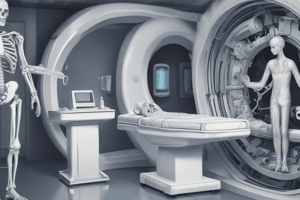Podcast
Questions and Answers
The modulation transfer function (MTF) is a basic feature used to assess imaging system performance.
The modulation transfer function (MTF) is a basic feature used to assess imaging system performance.
False (B)
The Rose model equation is a basic feature used to assess imaging system performance.
The Rose model equation is a basic feature used to assess imaging system performance.
False (B)
The Wiener spectrum is a basic feature used to assess imaging system performance.
The Wiener spectrum is a basic feature used to assess imaging system performance.
False (B)
Resolution, contrast, and noise are intermediate measures of imaging system performance.
Resolution, contrast, and noise are intermediate measures of imaging system performance.
The three basic features of imaging system performance are noise, spatial resolution, and signal-to-noise ratio.
The three basic features of imaging system performance are noise, spatial resolution, and signal-to-noise ratio.
The receiver operating characteristic (ROC) analysis is a comprehensive measure of system performance.
The receiver operating characteristic (ROC) analysis is a comprehensive measure of system performance.
The modulation transfer function (MTF) is a comprehensive measure of system performance.
The modulation transfer function (MTF) is a comprehensive measure of system performance.
The Rose model equation, contrast detail analysis, and receiver operating characteristic (ROC) analysis are intermediate measures of imaging system performance.
The Rose model equation, contrast detail analysis, and receiver operating characteristic (ROC) analysis are intermediate measures of imaging system performance.
The contrast of the disk relative to the background is a dimensionless quantity.
The contrast of the disk relative to the background is a dimensionless quantity.
Impressionist paintings are an example of how random noise affects image quality.
Impressionist paintings are an example of how random noise affects image quality.
Random noise in x-ray imaging is a result of using too many photons per area.
Random noise in x-ray imaging is a result of using too many photons per area.
Random noise can be measured as the mean of image values in a uniform region of the image.
Random noise can be measured as the mean of image values in a uniform region of the image.
A scannning microdensitometer is used to measure the noise level in an x-ray image.
A scannning microdensitometer is used to measure the noise level in an x-ray image.
Film contrast is always negative in x-ray imaging.
Film contrast is always negative in x-ray imaging.
The graph of relative exposure levels for phantom and background is a measure of image contrast.
The graph of relative exposure levels for phantom and background is a measure of image contrast.
Random noise is reduced by increasing the number of photons per area in x-ray imaging.
Random noise is reduced by increasing the number of photons per area in x-ray imaging.
In medical images, contrast refers to the similarity between neighboring tissues.
In medical images, contrast refers to the similarity between neighboring tissues.
The contrast between bone and soft tissue is low in x-ray imaging.
The contrast between bone and soft tissue is low in x-ray imaging.
The type of device used to record the image is a factor that affects radiographic contrast.
The type of device used to record the image is a factor that affects radiographic contrast.
The energy spectrum of the x-ray beam does not affect radiographic contrast.
The energy spectrum of the x-ray beam does not affect radiographic contrast.
Fogging or some other baseline signal is not present in the imaging device.
Fogging or some other baseline signal is not present in the imaging device.
Image contrast is calculated using the x-ray fluence (photons/area) of the object and its surrounding background.
Image contrast is calculated using the x-ray fluence (photons/area) of the object and its surrounding background.
The x-ray exposure is higher beneath the plastic disk than in the background in the developed x-ray image.
The x-ray exposure is higher beneath the plastic disk than in the background in the developed x-ray image.
The chemical composition of the object does not affect radiographic contrast.
The chemical composition of the object does not affect radiographic contrast.
Flashcards are hidden until you start studying
Study Notes
IMAGING SYSTEM PERFORMANCE
- The basic features used to assess imaging system performance are resolution (spatial), contrast, and noise.
- Measurements of these basic features provide a foundation for studying and comparing medical imaging systems.
- Measures derived from pairs of these basic features provide further insight and include:
- Signal-to-noise ratio (SNR)
- Modulation transfer function (MTF)
- Wiener spectrum
- The most comprehensive measures of system performance incorporate all three basic features and include:
- Rose model equation
- Contrast detail analysis
- Receiver operating characteristic (ROC) analysis
Image Contrast
- Image contrast refers to differences between neighboring tissues in medical images.
- Contrast depends on several factors, including:
- Chemical composition of the object
- Type of device used to record the image (film or electronic detector)
- Energy spectrum of the x-ray beam (presence of scatter radiation)
- Fogging or baseline signal in the imaging device
- Contrast can be calculated using the fractional difference in x-ray exposure between the object and its surrounding background.
Random Noise
- Random noise relates to the uncertainty or imprecision with which a signal is recorded.
- Noise is similar to the concept of impressionist paintings, where the number of dots increases, the precision or certainty with which the image is represented increases.
- In x-ray and nuclear medicine imaging, an image recorded with a small number of photons/area generally has a high degree of uncertainty or is noisy, while an image recorded with a large number of photons/area is more precise and less noisy.
- Noise can be measured as the standard deviation (σ) of image values in a uniform region of the image.
Studying That Suits You
Use AI to generate personalized quizzes and flashcards to suit your learning preferences.




